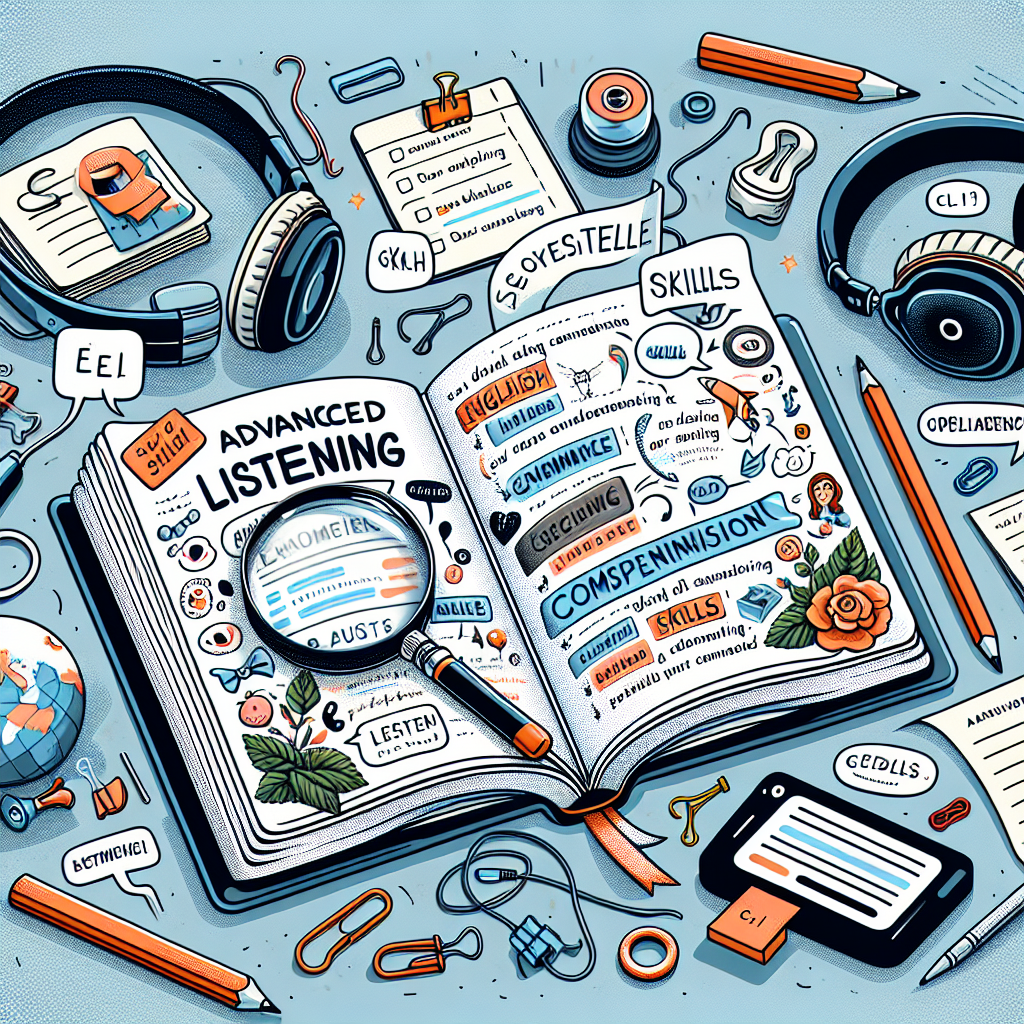Master Advanced Listening and Comprehension Skills for C1 Learners
Why Advanced Listening Skills Are Crucial for C1 English Learners
Contents
- 1 ` headings to create an SEO-friendly article focused on “Advanced Listening and Comprehension Skills for C1 Learners.” The headings are designed to address topics that users interested in this keyword are likely to be searching for. “`html Master Advanced Listening and Comprehension Skills for C1 Learners Master Advanced Listening and Comprehension Skills for C1 Learners Why Advanced Listening Skills Are Crucial for C1 English Learners
- 2 Key Techniques to Enhance Your Listening Comprehension
- 3 Top Resources for Practicing Advanced Listening Skills
- 4 Understanding Different Accents and Dialects in English
- 5 Measuring Progress in Listening Comprehension for C1 Learners
“`html
Advanced listening skills are a cornerstone of effective communication, especially for C1 English learners aspiring to reach a near-native level of understanding. As these learners move towards higher proficiency, the nuances of spoken language, including idiomatic expressions, varied accents, and implicit meanings, become increasingly significant. Mastery in listening is not merely about recognizing words; it’s about comprehending the intent, emotion, and subtleties that are often conveyed through tone, pace, and inflection.
For C1 learners, excelling in listening can have profound implications for academic and professional success. In academic settings, it allows students to absorb complex material presented in lectures and seminars, while in professional environments, it enables effective participation in meetings and negotiations where advanced vocabulary and industry-specific jargon are commonplace. Moreover, as C1 English learners often interact with a diverse range of speakers, advanced listening abilities are essential for adapting to different speech patterns and cultural nuances.
Confronting the Challenges of Advanced English Listening
Fine-tuning one’s listening capabilities at this level entails overcoming specific challenges, such as distinguishing between homophones or catching every word in rapid, natural speech. Enhanced listening skills bolster the ability to follow and contribute to conversations without needing clarifications or repetitions, which demonstrates both confidence and competence in the language.
Therefore, it is critical for C1 learners to engage with a variety of listening materials and exercises. These materials should range from academic lectures and podcasts on diverse topics to movies and radio shows featuring idiomatic language use. By challenging themselves with such varied auditory inputs, learners extend their vocabulary, improve their aural decoding skills, and build resilience against common listening barriers.
“`
Key Techniques to Enhance Your Listening Comprehension
Listening comprehension is an essential skill for personal and professional development. To improve your ability to understand spoken language, it’s important to actively engage with the content. This means not just hearing the words, but concentrating on understanding the message being conveyed. One effective technique is to practice focused listening. This can be done by choosing audio or video recordings on topics you find interesting and giving them your undivided attention, free from distractions. By doing so, you can train your mind to distinguish nuances in tone, speed, and accent that are crucial for comprehension.
Another key strategy involves the use of transcripts or subtitles while listening to the spoken material. Initially, as you listen, read along with the transcript or subtitles to match the written words with the spoken ones. Over time, challenge yourself to listen without the help of text, which will enhance your listening skills significantly. Utilizing this technique gradually transitions your brain from relying on visual cues to focusing solely on audio cues, thus strengthening your auditory comprehension ability.
Additionally, deliberate practice and repetition play vital roles in improving listening comprehension. Repeatedly listening to the same piece of content helps to familiarize your ears with certain voices or accents, making it easier to understand them in different contexts. Pair this strategy with summarizing or paraphrasing what you have heard, either aloud or in writing. This exercise ensures that you are not only hearing the words but are also processing their meaning effectively. As you continue to practice, you will notice a gradual improvement in your ability to comprehend and retain the information you hear.
Top Resources for Practicing Advanced Listening Skills
Perfecting advanced listening skills requires a variety of inputs and practical experiences. It’s not merely about understanding the words spoken; it’s about grasping subtleties, nuances, and the cultural context enveloping the conversation. The quest to refine these skills can be challenging, but certain resources stand out for their effectiveness in propelling one’s listening capabilities to the next level.
One highly recommended resource is podcasts. Podcasts offer a treasure trove of subjects, ranging from current events to niche topics, all of which are perfect for honing listening comprehension. Platforms like Spotify, Apple Podcasts, and Google Podcasts curate a wide selection of podcasts that cater to various interests and proficiency levels. Notable among these are podcasts specifically designed for language learners, featuring episodes that can help listeners fine-tune their understanding of idiomatic expressions and colloquial language.
The digital era has also given rise to language learning applications and websites that include advanced-level listening exercises. Tools such as Rosetta Stone, Pimsleur, and Babbel offer guided lessons with real-life dialogues, gradually increasing in difficulty, allowing for a steady progression in listening aptitude. Additionally, interactive listening modules within these platforms encourage active listening, a critical component for those seeking to enhance their auditory skills beyond mere passive consumption.
Engagement with media in the target language is another powerful asset for sharpening listening skills. Watching films, television shows, and news broadcasts in the language of study not only exposes listeners to authentic linguistic materials but also helps acquaint them with various dialects and accents. Services like Netflix, Hulu, and YouTube provide access to a wide range of international content, often with subtitles that can be used strategically to compare written with spoken language, thereby refining one’s listening proficiency in real-world contexts.
Understanding Different Accents and Dialects in English
Accents and dialects serve as a linguistic tapestry that reflects the diverse experiences and backgrounds of English speakers around the world. An accent, distinct from a dialect, refers to the unique pronunciation patterns a person or group might have. To truly understand the breadth of English accents, one must consider factors such as geographical location, social class, and historical influences. For instance, the rolling ‘r’ sound commonly heard in Scottish English is notably different from the silent ‘r’ often found in non-rhotic accents like many of those in the southern parts of England.
On the other hand, dialects encompass a broader spectrum of language, including not just pronunciation, but also vocabulary, grammar, and idiom. They are representative of a region’s culture and history, often containing unique words or expressions that aren’t found elsewhere. A classic example is the diverse range of vernacular seen across the United States, from the Southern drawl that elongates vowels to the clipped cadence of New England speech. Each of these dialects showcases distinctive linguistic traits that can be traced back through the region’s settlers and indigenous peoples.
Understanding these accents and dialects is not merely an academic pursuit; it has real-world implications for communication, education, and global business. In a multicultural and interconnected society, the ability to recognize and respect various forms of spoken English is critical. This is especially true in domains such as language teaching and cross-cultural interactions, where a deep appreciation for these differences can enhance the effectiveness of communication and reduce misunderstandings.
Interestingly, with the rise of digital media and international travel, we are witnessing the evolution and sometimes convergence of these accents and dialects. Television, films, and online platforms can expose individuals to a vast array of English language variations, sometimes leading to a blending of language features or the adoption of a ‘General American’ or ‘Received Pronunciation’ English in certain contexts. This dynamic nature of language continually shapes how we perceive and engage with the rich tapestry of English accents and dialects.
Measuring Progress in Listening Comprehension for C1 Learners
Assessing listening comprehension for C1 level learners entails a nuanced approach, as individuals at this advanced stage possess a strong grasp of the language’s subtleties. Progress evaluation often includes a diversity of audio materials that reflect complex concepts and implicit meanings. It is critical to use recordings that challenge a learner’s ability to understand a range of accents, levels of formality, and registers. These include comprehending lectures on abstract topics, following debates with multiple viewpoints, and interpreting idiomatic expressions frequently used in native-speaking environments.
One effective method of measuring listening progress is through targeted listening tasks which require completion after exposure to audio. Tasks including summaries, inferences, and specific information retrieval not only test a learner’s comprehension but also their ability to process and reproduce information in English. For instance, a C1 individual should be able to listen to a conference talk and jot down key points that capture the core message, as well as the speaker’s attitude and intonation which often convey unspoken context.
Another valuable metric for gauging listening comprehension is the analysis of learner response time. At a C1 level, a reduced reaction time when responding to complex audio indicates a proficiency similar to that of a native speaker. This entails not only understanding spoken language in real-time but also being capable of immediately interacting in situations such as negotiations or problem-solving discussions that involve a high level of linguistic fluency and cultural awareness.
Utilizing Technology in Listening Assessment
With the advent of language learning technology, a plethora of tools now enable learners to track and measure their listening skills effectively. Applications that tailor listening exercises to each user can provide immediate feedback and detailed analytics, helping learners identify specific areas of strength and those requiring further improvement. This real-time data and the ability to revisit audio passages allows for a focused approach to refining listening abilities at the C1 level.


